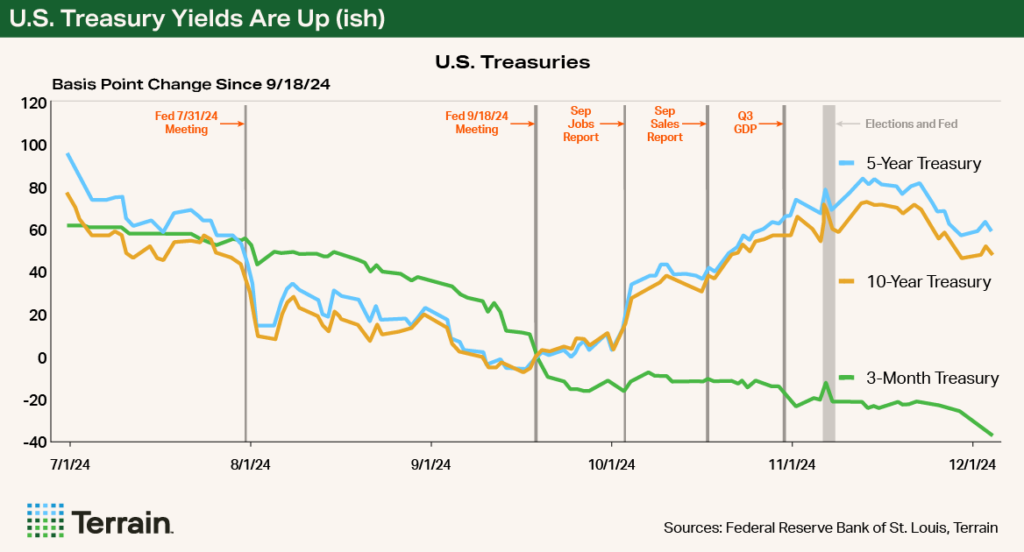Economic Growth Dampens Rate Cut Hopes
Article Originally Published in the January Issue of the National Cattlemen Magazine
By Matt Clark, Senior Rural Economy Analyst
Multiple regional wars around the world. A change in the White House. A change in the Senate majority. Somewhat sticky inflation alongside a marginally higher savings rate. Stronger-than-expected economic growth amid poorer consumer sentiment. This host of uncertainties and paradoxes is what the U.S. economy and the Federal Reserve are facing. So far, the Fed has done a good job navigating a unique economic cycle, but the reality is that the central bank will likely not provide the rate cuts most of us would like to see in 2025.
The Fed’s Federal Open Market Committee (FOMC) members have done a good job estimating how economic conditions would play out amid all these uncertainties. In the FOMC’s December 2023 dot plot, their estimates for 2024 unemployment, inflation and the federal funds rate are nearly spot-on despite underestimating gross domestic product (GDP) growth.
So far, the stronger-than-expected economic growth has not reignited inflation substantially. The pace of inflation has moderated enough that the Fed cut the federal funds rate by 25 basis points on November 7, bringing the volume of total cuts in 2024 to 75 basis points. For context, every 100-basis point, or 1%, cut in the fed funds rate saves about $1,000 of interest on a $100,000 loan with a single-year payout.
Looking forward, however, the market’s expectations for more Fed rate cuts in 2025 have become muted, as the data continue to point to above-trend economic growth. Fed Chairman Jerome Powell added fuel to the fire when he commented on November 14 that “the economy is not sending any signals that we need to be in a hurry to lower rates.”
Cattlemen Likely to See Only Slight Rate Relief in 2025
For cattlemen, variable interest rates likely moved, or will move, slightly lower with the most recent Fed rate cut. However, the expectation that variable rates will move significantly lower has dimmed. Interest rate costs in 2025 should be lower than a year ago but not significantly.
Likewise, yields on longer-term Treasuries have moved higher alongside positive economic news and concerns over longer-term inflation and government deficits. As yields on longer-term Treasuries move higher, interest rates for loans on longer-term assets such as farmland tend to move higher as well. For cattlemen, this implies that interest rates on longer-term loans will likely remain elevated, though slightly down from year-ago levels.


As agriculture heads into a period of renewals, land auctions, taxes and general financial planning, interest rates will likely be a hot topic with accountants, brokers and Farm Credit lenders. Any further interest rate relief will depend on the general health of the U.S. economy and, specifically, the Fed’s dual mandate for economic health: Maintain stable prices — by keeping a close eye on inflation — and maximum employment.
The labor market had also been on a path of strength for much of 2024, but there have been some recent signs of weakness. For example, after the level of total private employees had increased for 45 consecutive months dating back to January 2021, lackluster job growth in October brought the trend to a stop.
However, given the strong November jobs report, it appears that the October job situation was a result of hurricanes and labor strikes. Regardless, the Fed is clearly focused on keeping an accommodative labor market.
Looking forward, it seems unlikely that the labor market will sharply contract. Some indicators such as announced layoffs indicate some softness. But overall, unemployed numbers remain historically low, indicating a still-robust job market that may slow the pace of Fed interest rate cuts.
Price Rates Like Your Commodities
I believe that it is important to take the Fed members at their word: They are not on a set interest rate path, and they will remain data-dependent.
A best practice in this environment is to have an interest rate plan like a commodity marketing plan. Work with your Farm Credit lender to stress-test your financial performance at different interest rates and have a plan for when to lock, when to remain variable, or when to refinance should interest rates move sharply in one direction.
Terrain content is an exclusive offering of AgCountry Farm Credit Services,
American AgCredit, Farm Credit Services of America and Frontier Farm Credit.